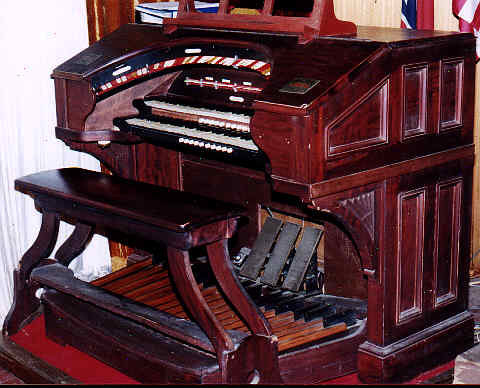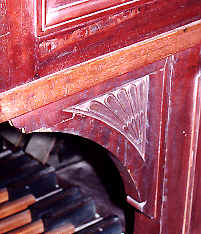
Back to Main Encylopaedia Contents
Paramount Theatre, Melbourne

Source: Vox, TOSA (Vic), Melbourne, May, 1973
The Paramount Theatre, in Bourke Street, opened on 27 December, 1915, seating 1500. It was upgraded in 1921, with 400 more seats.[Thorne, Ross, Cinemas of Australia via USA, p. 252]
Initially, Signor Kost's orchestra provided the musical accompaniment to the films. [Thorne, Ross, Cinemas of Australia via USA, p.252] The two-manual, seven-rank Wurlitzer from the De Luxe Theatre was moved to the Paramount, where it was opened by Manny Aarons in 1927.
At the Paramount, it was installed with the console at the left-hand side of the orchestra pit, and the pipework would appear, from photographs, to have been installed in a former decorative box built into the left-hand side of the proscenium arch.
At the De Luxe, the organ was equipped with a separate roll-playing console. Photographs of the Paramount do not show this; it might have been installed there in the early days, and then removed after silent films ceased, but no evidence of this has come to light.
As far as is known, no alterations to the specification of the organ were made during the removal, and it thus remained (apart from the player unit) as it was at the De Luxe. It is perhaps a little surprising that the opportunity was not taken to add a Tibia Clausa.
By the mid 1930s, the theatre had been renamed the Lyceum, [Thorne, Ross, Cinemas of Australia via USA, p.252] and the organ remained there until around 1946. Who played it, or for how long it was used, is not known.
In 1946, it was removed, and its parts were added to the three-manual, fifteen-rank Wurlitzer from the Ambassador's Theatre, Perth, to create a four-manual, nineteen-rank organ for the Regent Theatre, Melbourne, which was rebuilt after that theatre and its original organ were destroyed by fire in 1945.
Four of the ranks of pipes from the Paramount (Lyceum) organ were modified to provide Tibia Plena, Oboe Gamba, English Horn and Open Diapason ranks for the "new" organ. One of the manuals is believed to have been used to enlarge the ex-Perth console to four manuals. Disposal of the remainder of the instrument is undocumented. It has been said that an attempt was made to sell the residue to Wurlitzer's former agent, W Crowle, but if this were so, he was not interested in the offer.
It is my belief that the console shell found its way to the Seventh Day Adventist church at Concord, NSW, and then via Canberra to the Majestic Theatre in Pomona, Queensland. The SDA organ at Concord is widely said to have been fitted with the console from the Strand Theatre, Hobart. However, the Strand organ was provided with a piano-style console, which in no way resembled the SDA's horseshoe console.


Unfortunately, only the shell of a Wurlitzer console exists at Pomona, all the stopkeys, manuals and interior mechanisms having been replaced at one or more times in the past, and it is not possible to confirm with absolute certainty that it came from the Paramount. The evidence in favour of the hypothesis is that the design of the console shell (especially the brackets and panelling) is exactly right for a two-manual Wurlitzer console built in 1920 (consoles built later have detail differences), and no other two-manual horseshoe Wurlitzer console of the correct vintage is unaccounted-for in Australia.
The Lyceum was rebuilt and renamed the Cleopatra in 1964, for the long run of the film of that name, after which, until it was closed and demolished, it was known as the Paris Theatre. [Thorne, Ross, Cinemas of Australia via USA, p.252]